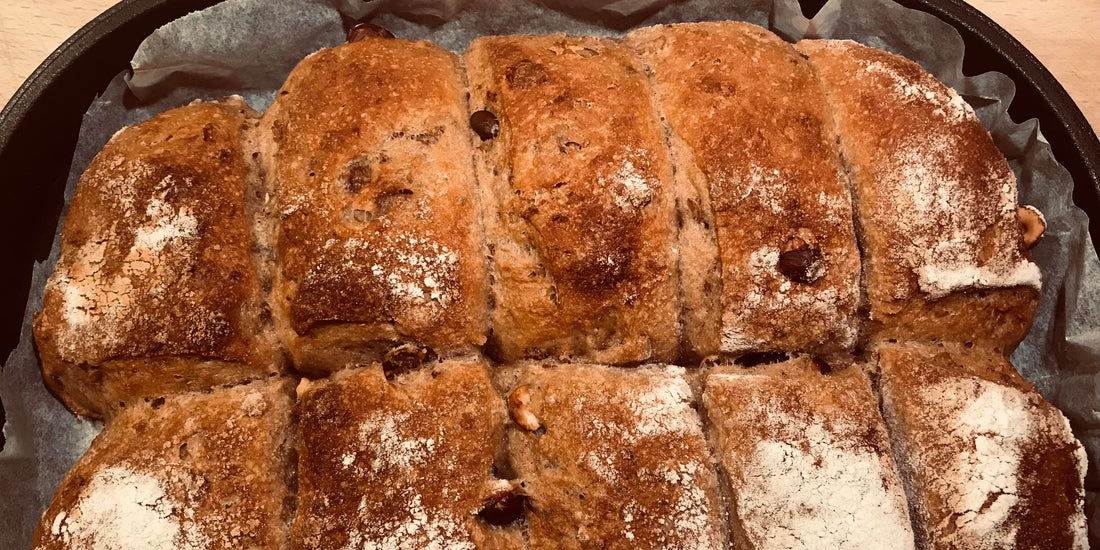
Muesli bread with einkorn flour, creme fraiche and sesame oil (8-10 buns)
Share

|
Ingredients: Einkorn flour, stone-ground wheat flour, finely sifted wheat, sour cream, light sourdough, salt, sesame oil, muesli, raisins, hazelnuts. Tool: Dough spatula, rising basket, tea towel and possibly a cast iron pot with a flat lid. |
Day 1: Sourdough refreshed (2 min) Day 2: The dough is mixed and folded (4 hours) Day 3: Bread is shaped and baked (2 hours) |
If I can choose between a piece of pastry and a gross bun with fruit and/or nuts, guess what I grab? I managed to live in Paris for five years as a youngster without eating a single croissant (not kidding!). Because every time I had to choose a snack at the bakery, I was tempted by the small pains spéciaux – coarse pieces with different fillings. The other day I got a really good muesli bun from Emmerys, and I just went home and threw together a dough for breakfast the next day. It became this version with some leftover creme fraiche, which was in imminent danger of turning sour and boring, and a splash of sesame oil – just because. There is no hocus pocus about the muesli: it was actually the cheapest organic of its kind, with extra raisins and a lot of hazelnuts added. I halved the nuts: it's well worth the trouble, because it's a pretty miserable experience to get a rancid nut in your mouth. If it's brown inside, it needs to come out here and not as much as near the dough!
If you don't have any muesli lying around, you can just whip one up from whatever flakes and dried fruit you have. And if you don't have creme fraiche, yogurt or a little cream cheese can work: if you use cream cheese, just use a good spoonful and dilute with a little extra water (note the texture of the dough before folding in the muesli: it must be slightly firm but elastic). You can also completely omit it and get a crispier crust and a slightly tougher crumb (replace with water).
The point of a muesli bun is that there must be something to chew on. It's no use sitting around with a magnifying glass and a compass to find a stray raisin! And in my opinion, putting cinnamon or cardamom in this kind of pastry is a waste. Lovely spices, for sure. Just not in my muesli bread!
Tool:
Metal dough spatula, a rising basket (or other basket - see below), tea towel and possibly a large cast iron pot with a flat lid.
Ingredients:
150 g whole wheat flour
100 g stone-ground wheat flour
250 g finely sifted stone-ground wheat flour (type xx)
Approx. 50 g sour cream
Approx. 300 g water (possibly a little more depending on how wet the flour absorbs)
Approx. 100 refreshed sourdough
1 tablespoon sesame oil (equivalent to approx. 10 g)
12 g of salt
Approx. 1 dl muesli + a few good handfuls of raisins and two hazelnuts (other types of dried fruit and nuts can also be used) soaked in 2 dl boiling water.
Rice or buckwheat flour to sprinkle basket/tea towel with
Day 1, morning: freshen up your sourdough (the buns can certainly also be baked on an "old" (but active) sourdough directly from the fridge - then you just have to settle for half the amount of sourdough, set aside a little extra time for the first rise and live with a more acidic result)
Day 2, afternoon/evening:
- Pour boiling water over muesli (including extra fruit and nuts) and set aside.
- The types of flour are mixed in a large milk dish or similar. Make a well in the middle of the flour for the wetness.
- Creme fraiche, sourdough and most of the water are mixed well and poured into the flour. Slowly work the flour into the wet, do not knead here, just make all the flour wet. The result is an ugly, uneven porridge - that's exactly how it should be.
- Let the dough rest for approx. ½ hour.
- The salt and the last water are added and worked well into the dough and left to rest.
- After ½ hour, the dough is stretched and folded 4-5 times, as Michael shows in the video clip below, after which it rests again.
- After another half hour, the muesli porridge is folded into the dough; if you don't have a large dish that allows the dough to spread over a relatively large surface, you can lay it out on the table: spread the porridge over the dough in an even layer and press it down well. Then fold the dough over itself by grasping one side and folding it all the way over to the opposite edge; turn the bowl a quarter of a turn and repeat 4-5 times until you can feel that the dough is completely stretched and the porridge lies in many fine layers between layers of dough.
- During the next hour or a half, the dough is gently folded a few times approx. every half hour.*
- When the dough has risen approx. 20-30%, it is shaped into a loaf and placed in a rising basket. I used an oval because I am the happy owner of a monster of a cast iron pan. But if you have a fairly ordinary round one of this kind, you can cleverly use a round rising basket - or whatever you have: a bread basket or a colander lined with a well-floured tea towel works just fine. I can recommend rice flour or buckwheat flour, which ensures with 100% certainty that the dough does not stick to the cloth. And if you don't have a cast iron pan, don't worry! The muesli crumbs are not so delicate - see further down.
Day 3, morning:
- When a floured finger leaves only a faint mark on the surface of the dough if you press down on it, it is ready to be baked. And the window for when it is ready is somewhat larger than for a loaf: where a loaf becomes rather flat and boring from having risen a little too long, it is not quite the same with buns. They are somewhat more tolerant.
- If you have a pan with a flat lid, put it in and let it heat up with the oven to 250 degrees. If you don't have one, you just leave a baking sheet in the oven and heat it with it.
- When the oven is hot, take out the pot/baking tray. The bread is carefully turned out in the lid/on the baking sheet (I almost always use baking paper, although it is strictly speaking not necessary on cast iron). Then sprinkle the bread generously with flour before dividing it into 8-10 pieces with the dough spatula: an oblong loaf is divided first lengthwise and then crosswise 4 times. A round loaf is divided into layer cake pieces.
- The lid is put on and all the glory is put into the oven. If you bake without a pan, you can throw a cup of water into the bottom of the oven immediately after putting the bread in: it gives off a little steam so that the crust doesn't set straight away.
- The buns must be baked for approx. 15 minutes with lid and 20-30 min. without a lid at 220 degrees (check after a total baking time of approx. 35 min and if necessary, bake a little more by accident: take out a bun and tap it under the bottom – when it sounds hollow and has a good crust, they are ready; have If you use a roasting thermometer, it's also a good guide: at 98 degrees in the middle, they're done).
- Let them cool on a wire rack as long as breakfast hunger allows, then enjoy a few split and smeared with well-salted butter or your favorite cheese. Bon appetite!
* In a previous recipe with porridge, I wrote that I rarely stretch and fold the dough after I have added porridge, seeds, fruit, etc., because it is easier to handle if the surface is unbroken - that is, it does not crack and let it sticky porridge coming out of its fine layers. But when the dough is "just" for buns, it doesn't matter so much, I think. However, I like to use the so-called coil folds instead, which are gentler. The technique in all its simplicity is that, instead of pulling up the sides of the dough, you relax your hands under the center of the dough from each side, lift up and let one, soon the other end of the dough fold under itself. Think of a cat that arches its back and gently tucks its paws under its chin and belly... A few times is usually enough when the dough is full of all sorts of things.
How to fold the dough (Excerpt from Rugkop's online baking course )
Anyone can learn to bake light sourdough bread. Buy our online course and get flour and equipment delivered to your door.

1 comment
Hejsa.
Bageriet Pompei i Ribe laver nogle helt vilde müsli boller/stænger til blot 8 kroner stykket (hvis du en dag kommer forbi).
Er ret sikker på de er lavet på rugdej.
Det er til dato de bedste jeg har smagt her i kongeriget.
Forsøger desperat at finde en opskrift der kan lede mig i den retning.
Tak for godt indhold på din blog.
Mvh
Johan